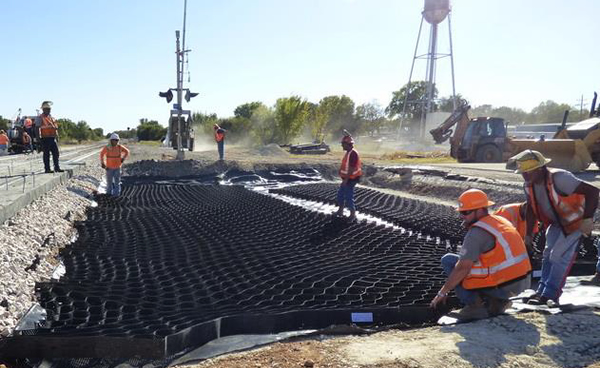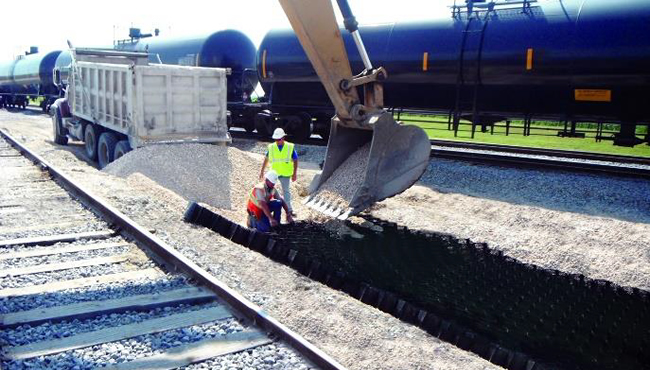Oregon State University’s Dr. Ben Leshchinsky, P.E. and the University of Kansas’s Dr. Jin Han, P.E. recently combined their wealth of geosynthetics knowledge in a track ballast research study. Specifically, they evaluated the performance of a high-density polyethylene geocellular system (HDPE GEOWEB® from Presto Geosystems) in a railway base stabilization system.
The rigorous track testing quantified the beneficial impact of reinforcing track ballast with GEOWEB confinement (in contrast to unconfined ballast).
The research team found that the use of the HDPE geocellular base stabilization system reduced ballast movement and settlement, decreased subgrade pressures, and increased stability and rail performance, “all of which translates to a substantial reduction of maintenance and increased ballast life, even over weak subgrades,” Presto noted in a statement on the research.
Leshchinsky and Han’s research backs up and adds to the results from the 2.5-year under-track research program that was previously conducted at the Facility for Accelerated Service Testing (FAST) at the Transportation Technology Center (TTCI) in Pueblo, Colorado.
“The results are not at all surprising,” notes Presto Geosystems’ Director, Bill Handlos, P.E. “We’ve been working with the railroads for over 30 years to stabilize their track ballast and shore up embankments. This research will help more railroads realize the benefits of GEOWEB-confined ballast and reduce capital and maintenance expenses each year for the upkeep of high-quality ballast layers.”
On its website, the company has provided summaries of the results from analyses at OSU and KU.
GEOCELL-CONFINED TRACK BALLAST RESEARCH HIGHLIGHTS
KU Research
Dr. Han’s track ballast research at KU included plate and track loading tests to substantiate GEOWEB-confined ballast performance over weak sub grades subjected to heavy freight loadings.
- The geocelluler sytem’s long-term confinement significantly reduces ballast movement and rotation, resulting in increased ballast life
- Lateral confinement controls movement of ballast particles so that breakage, vertical compression, and spreading is minimized, which leads to improved rail performance.
- Decreased subgrade pressure by 50%, which provides stiffer and more stable track that allows heavier loads and faster speeds over low subgrades
- KU Research Summary (PDF)
OSU Research
Dr. Leshchinsky utilized state-of-the-art, three-dimensional dynamic Finite Element Modeling to quantify the reinforcement benefits of the HDPE geocell-confined ballast.
- The long-term confinement influence of the GEOWEB designreduces settlement by up to 50% under heavy freight loadings over weak sub grades
- The controlled lateral ballast heave provides a more stable track, leading to decreased maintenance and ballast tamping
- For heavy freight loadings, strains in the GEOWEB system were low (<1%) with maximum tensile stresses at the bottom corners of the cell showing the importance of seam strength
- OSU Research Summary (PDF)

Photo by Presto Geosystems
Learn more about geocellular systems and applications, green engineering (e.g., porous pavement design), and more at www.prestogeo.com.












